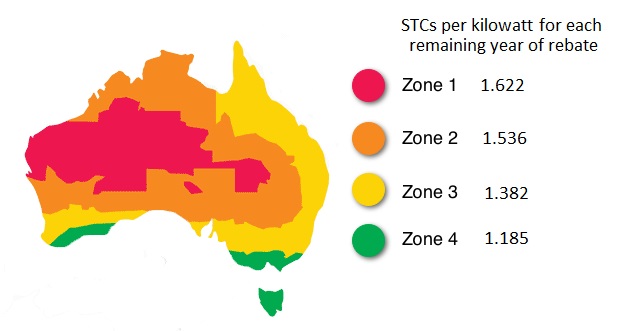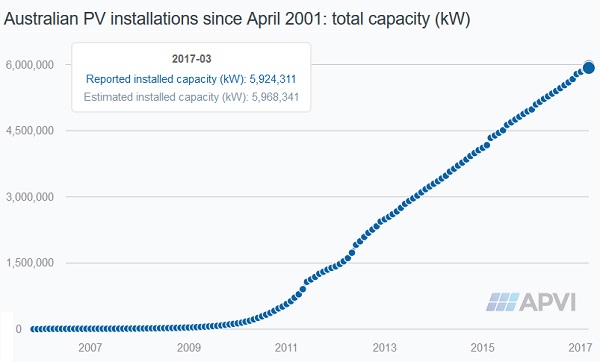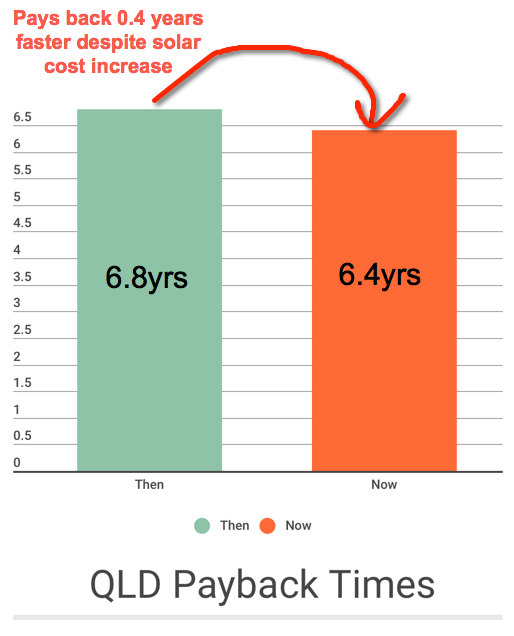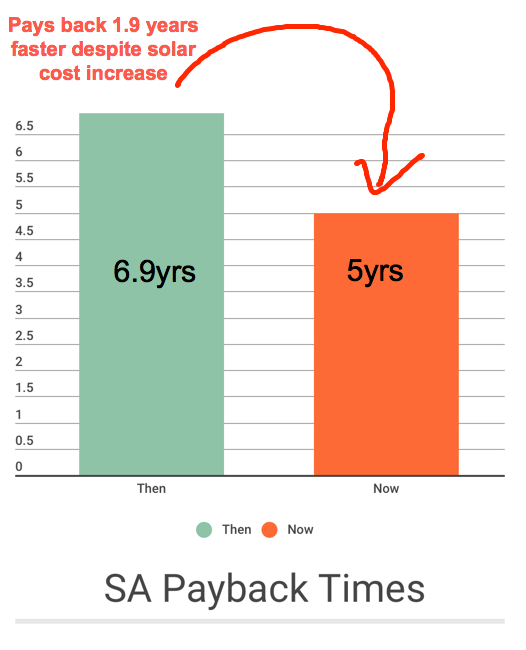
STC prices dropping means solar prices have risen. What has that done to solar payback times?
We were warned.
We all knew this was coming.
But who among us was prepared for the recent tumble in the price of STCs that lower the cost of rooftop solar?
Well, I was.
And my cousin, Willy — he was prepared too.
And plenty of installers were prepared, especially those that have been around for a while and who have seen STC prices fall before.
Unfortunately, some installers were caught with their pants down because not all of them made it clear to their customers the quotes they gave contained a variable STC component that could change.
The fall in STC prices from just under $40 in May to $31 today increases the cost of a 5 kilowatt solar system for most Australians by $860 due to a mechanism often called the “solar rebate1“.
So is rooftop solar still a worthwhile investment for Australians?
The short answer is — Hell yes.
And the long answer is — Heeeeeeellllllllllllllllllll yeeeeeeeeesssssssssssssss.
Most Australians suffered an increase in electricity prices on the first of July. Most have also received the benefit of increased feed-in tariffs. Together, these changes have resulted in an improvement in the economics of rooftop solar that outweighs the disadvantage caused by the fall in STC prices2.
Why Have STC Prices Fallen?
The value of STCs are determined by supply and demand. If the amount of solar whacked on roofs decreases faster than expected then their value goes up. This lowers the cost of solar and encourages people to buy more. And if a lot of rooftop solar is installed, the value of STCs fall, which discourages people from getting it.
The reason why supply and demand affects STC prices is because they are part of Australia’s Renewable Energy Target. Since it is a target, a system was put in place that gives some control over the amount of rooftop solar installed to allow the target to be hit.
While the amount of rooftop solar has had its ups and downs as incentives have changed, the overall amount installed each year has been relatively constant since STCs were introduced in 2011, as this graph I lifted from the Australian PV Institute site shows:
While the graph includes large scale solar farms, they are only just starting to take off in Australia and currently only amount to 5% of installed solar panels.
Will STC Prices Fall Further?
STC prices have fallen by almost one quarter since May, with most of the decline occurring in a single day. That’s a pretty major drop. If it happened to shares you’d need a broker proof umbrella to be safe when strolling past the stock market.
So can we be certain prices have stabilized at around $30 and a similar fall won’t occur again?
No, we can’t.
This is because markets are run by humans3 and humans are kind of dopey and are in the habit of doing really stupid things every now and then.
But, while we can’t be certain what will happen, we can be fairly confident a similar fall won’t happen any time soon. One reason is because STC prices have not changed as rapidly in the past as they did last month. While past prices have had their ups and downs, previous swings have been more subdued, as this graph from Green Energy Trading shows (look at the green line):
As the installation of rooftop solar has been increasing, I was expecting STC prices to fall at some point this year. And they did. But I’m not expecting another large decrease because I don’t think installations will increase enough to cause another large fall any time soon. But feel free to check with me in a few months and I’ll see how installations are going.
Will STC Prices Rise?
While STC prices may fall, it is also possible they will rise. I wouldn’t be surprised if they go up by a few dollars or perhaps more, but due to the increase in installations I don’t expect them get close to their maximum price of $40. At least not any time soon, and possibly never. So I can’t recommend waiting around to see if STC prices will improve before buying solar, as every month you go without rooftop solar is a month paying higher electricity bills than you need to.
The Increase In The Cost Of Solar Depends On Location
The amount of STCs received per kilowatt of solar panels depends on which Zone they are installed in. There are four Zones:

The solar rebate zones and how many STCs you get per kilowatt hour of solar panels for each remaining year of the solar rebate. (There are 14 years remaining in 2017.)
Most Australians live in Zone 3, which includes Brisbane, Sydney, Canberra, Adelaide, and Perth. A considerable number of people live in Zone 4 which includes Melbourne and Hobart. Not so many live in Zone 2, which includes Darwin. And people are few and far between in Zone 1, which includes a hell of a lot of dust.
The recent $8.90 fall in STC prices increases the cost of installing one kilowatt of solar panels this year by the following amount:
- Zone 1: $202
- Zone 2: $191
- Zone 3: $172
- Zone 4: $148
So the majority of Australians who live in Zone 3 will need to pay $860 more for a 5 kilowatt system, while people in Melbourne or Hobart will only have to pay $740 more for a 5 kilowatt system.
You May Not Need To Pay The Full Increase
In response to STCs taking a dive, a large number of installers have absorbed some of the increase in solar system prices themselves. While the cost of solar hardware does tend to decrease over time, and the Australian dollar has risen a couple of percent compared to the Chinese yuan4 over the past month, mostly it is coming out of their own margins. This does not make things easy for installers, as they typically make very little profit on each job they do.
So while people looking to get solar can feel hard done by on account of the fall in STC prices, most installers are feeling the same way.
If you don’t like the price offered by an installer you can shop around and look for a better deal. But it is definitely a good idea to make sure you use an installer who does professional work and uses quality hardware on account of how cheap solar can have a high cost.
Solar Is A Better Deal Than Ever For Most Australians
All else equal, the fall in STC prices has definitely made the economics of rooftop solar worse and increased its payback time. But all else is not equal. While most of the STC price fall took place on the 19th of July, most Australians had a hefty electricity price increase on the 1st of July. Feed-in tariffs have also increased in every state except Western Australia. When the effects of electricity price and feed-in tariffs increases are taken into account, rooftop solar is now a better deal for the majority of Australians than it ever was, despite the fall in STC prices.
A Queensland Example
My parents live in rural Queensland and so are spared from having to choose between electricity retailer plans5. Because they have a fixed electricity price and feed-in tariff it is very easy to see the increases since the 1st of July.
- Electricity Price Increase: 1.4 cents per kilowatt-hour — a 5.2% increase
- Feed-in Tariff Increase: 2.65 cents per kilowatt-hour — a 36% increase
For the sake of this example, let’s pretend my parents are normal6 and their electricity consumption is the same as a typical Queensland household and they want to install rooftop solar with the following characteristics:
- Solar panel capacity: 6.5 kilowatts
- Yearly production: 10,300 kilowatt-hours
- Solar electricity self consumption: 20%
- Cost: $8,000 (top of the range system)
In this case, before the July 1st increases in electricity price and feed-in tariff, and before the fall in STC prices, the system would have a simple payback period of 6.8 years.
If the full increase caused by an $8.90 fall in STC prices is passed on the cost becomes $9,118. With the electricity price and feed-in tariff increases that have occurred since July 1st its simple payback period will be 6.4 years, which is a clear improvement.
A South Australian Example
Unfortunately, in South Australia prices and feed-in tariffs are not fixed and we have to choose between electricity retailer plans, which is just terrible. This means, rather than using exact figures, I will use estimates I consider reasonable.
I will assume an Adelaide solar system installed before the fall in STC prices and the electricity price and feed-in tariff increases, had the following characteristics:
- Solar Panel Capacity: 6.5 kilowatts
- Yearly production: 9,300 kilowatt-hours
- Solar Self Consumption: 20%
- Cost: $8,000 (Only the best gear for Adelaideans)
- Grid electricity price: 30 cents
- Feed-in Tariff: 8 cents
Under these conditions, the system would have a simple payback period of 6.9 years.
If all the price increase caused by an $8.90 fall in STC prices is passed on the cost will rise by $1,118. Electricity prices have increased by around 17% since the 1st of July and our electricity price comparison tool says feed-in tariffs now range from 5.3 cents to 22 cents. As a result, I will assume the following now applies:
- Cost: $9,118
- Grid electricity price: 35 cents
- Feed-in Tariff: 16 cents
This results in the simple payback period being reduced from 6.9 to 5.0 years, which is an impressive reduction.
The Rest Of The Country
I am far too lazy to give examples for every state and territory, but I will tell you that the combination of decreased STC prices and electricity price and feed-in tariff increases mean the improvement in payback times in NSW, Victoria7, and the ACT, should be somewhere between that of South Australia and Queensland.
Because Tasmania has capped their electricity price for 12 months and only had a modest increase in their feed-in tariff, they will only have a small reduction in payback times.
Western Australia is the exception and their payback times have increased. This is because while they’ve had a large increase in electricity prices, it is almost all due to increased daily supply charges which don’t improve the payback time of solar. It also results in poor people generally paying more per kilowatt-hour of grid electricity than rich people, so it’s shameful behavior by those responsible. They have also had no improvement in their 7.1 cent feed-in tariff that applies to new solar outside of remote areas. The good news is that in WA solar was already such a good deal the extra cost from the fall in STC prices shouldn’t change anyone’s mind about getting solar, so long as their roof isn’t significantly shaded.
Payback times have gotten worse in the Northern Territory as well, but the feed-in tariff tariff there is the highest in Australia and equal to the cost of grid electricity, so it’s still an incredible deal. If you are in the Top End and haven’t got solar, go get it now. You’d have to be troppo not to.
The Future
While I can’t know what will happen to STC prices, I personally don’t expect another large fall or a return to their former high price. I do expect some variation, but I have no way of knowing which way it will go.
I am sure many Australians will be hit with further electricity price increases next year and feed-in tariffs are unlikely to decline soon. There will be a small decrease in the amount of STCs received at the start of next year as the scheme is gradually phased out, but this will only be enough to cause a minor increase in solar prices and the lower STC prices are, the less it matters.
The cost of solar panels, inverters, and other hardware will most likely continue to decline, although I think it will be at a slower rate than we’ve seen over the past year. I am 100% certain it won’t be fast enough to make it worthwhile to sit around and wait for it to get cheaper.
If rooftop solar made economic sense for you a couple of months ago, then chances are it will make even more economic sense now or, at the very least, will still be worthwhile. So I do not recommend waiting around to see if STC prices improve before getting solar. Sure, you might kick yourself if they suddenly rise right after you get a system, but they could just as easily fall and then you could do the opposite of kicking yourself. Which I guess would be patting yourself on the back with your foot.
Footnotes
- It looks like a rebate, it quacks like a rebate, but it’s not actually a rebate. (Fun fact: A rebate quack sounds more like a wounded giraffe.) ↩
- For the majority of Australians. Western Australia is an exception, but there the economics of solar were already so good it still makes sense to install it on almost any roof that isn’t significantly shaded. ↩
- With a great deal of effort, programmers have been able to make computers operate markets as irrationally as humans do. Whether this is reassuring or ominous, you’ll have to decide for yourselves. ↩
- Chinese currency can be called yuan or remembi and I can never remembi the difference between the two. Either way, the majority of our solar hardware comes from there. ↩
- Best argument for Communism evar! ↩
- This is probably the hardest thing I will ever ask you to do. ↩
- Victoria had their electricity price increases at the start of the year rather than July 1st. ↩






 RSS - Posts
RSS - Posts



And people are few and far between in Zone 4, which includes a hell of a lot of dust. * Should read _ Zone 1
Whoops! I must have been half asleep when I wrote that. All fixed now. Thanks for pointing it out.
A Chinese colleague once told me that renminbi means “currency”. A quick look at wikipedia gives “people’s currency”. The name of that currency is yuan.
Things are simpler in Strayan – “the dollar” means both.
Hi Finn, excellent site that I stumbled on. Of the three quotes you referred for me, two got back. One couldn’t quote until there is a house to quote for. The other had detailed prices up to nearly $10000 after rebates. Your example given above on your blog says SA power is 30cents, try 42c from AGL since July 1st. Also, you say that your Adelaide cost is the best at $8000. Many an ad in SA papers quote around the $4000 for a 5kW system. What a nightmare, thanks for trying to make it easier for us to understand.
I’m very lucky not to have been stung by this. I had a 6.5kw solar system installed on the 30th June, 12 weeks after I made a deposit, just before the fall in STC value. I bought from one of the quotes I received from this site. I made a deposit on the 4th April. At this time I was advised it was normally a couple weeks for installation even in my rural location but that the recent rain meant it might take a little longer. Luckily I did confirm that in the worst case it would be completed by the end of the financial year. Once the sales people had my deposit I was referred to the service department who confirmed that it would take much longer than that for my location. Luckily I was able to insist that the installation was completed by the end of the financial year as had been promised. I was asked a number of times why it was important to me that it was done by the end of the financial year and my reply was always because that was promised as the longest I would need to wait. If I had let them have their way then it would have likely cost me at least $1000
Just a totally unrelated side note – renminbi or RMB is basically the name of the currency, while Yuan is the denomination – similar to saying dollar, or pound.
Just put in a request for some quotes so I hope to have solar soon.
🙂 thank you for all the information on this site.
Gee, do your parents know that you don’t think they are normal. That is a harsh thing to say in a public forum man. :rolleyes: 🙂
It is now April 2020 and I have no idea what the tarrifs etc are worth now but we are having our panels hoisted onto the roof tomorrow. Hope the rain holds off. Thanks for you site and the info provided. It is much appreciated. :thumbsup: